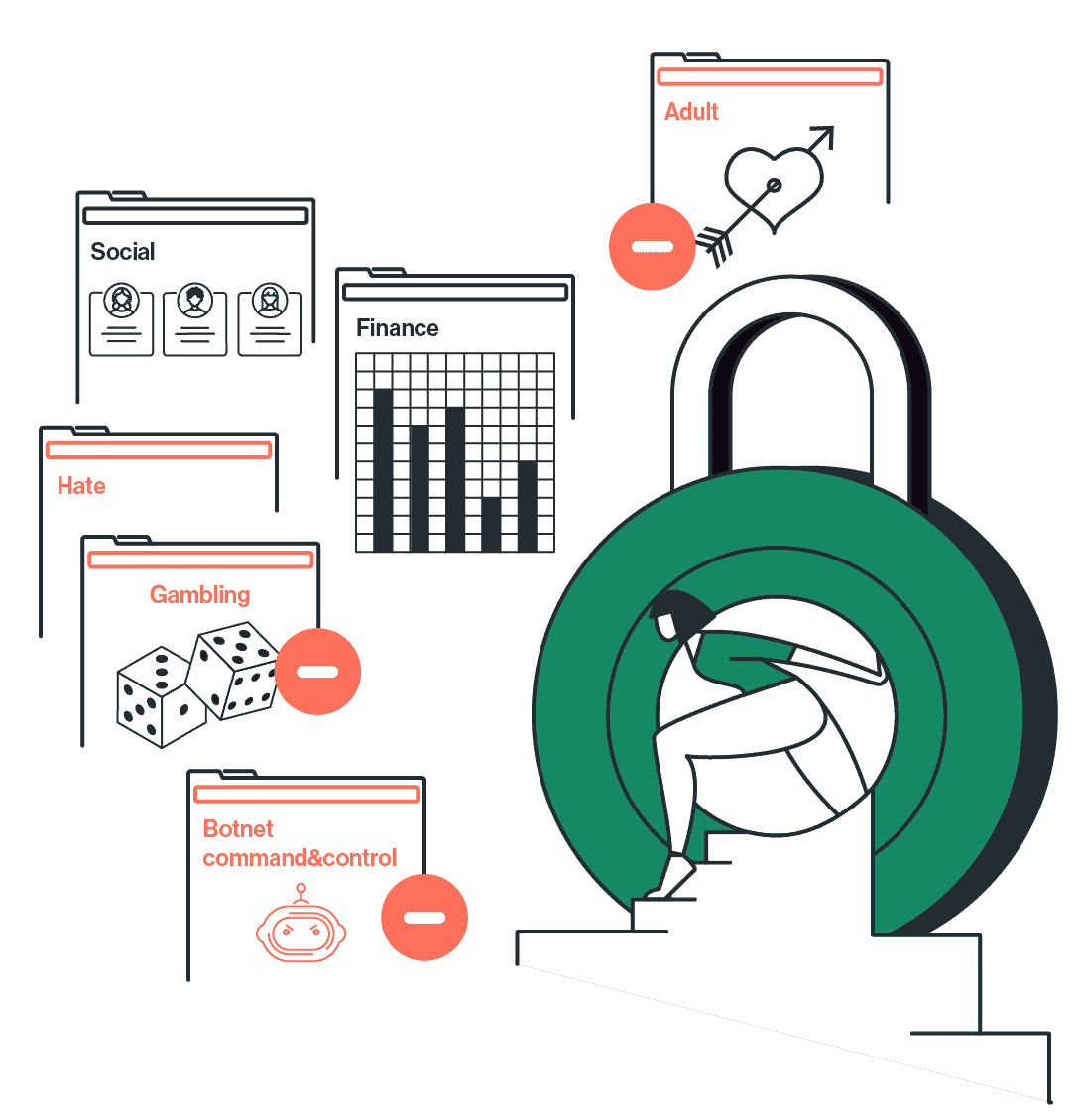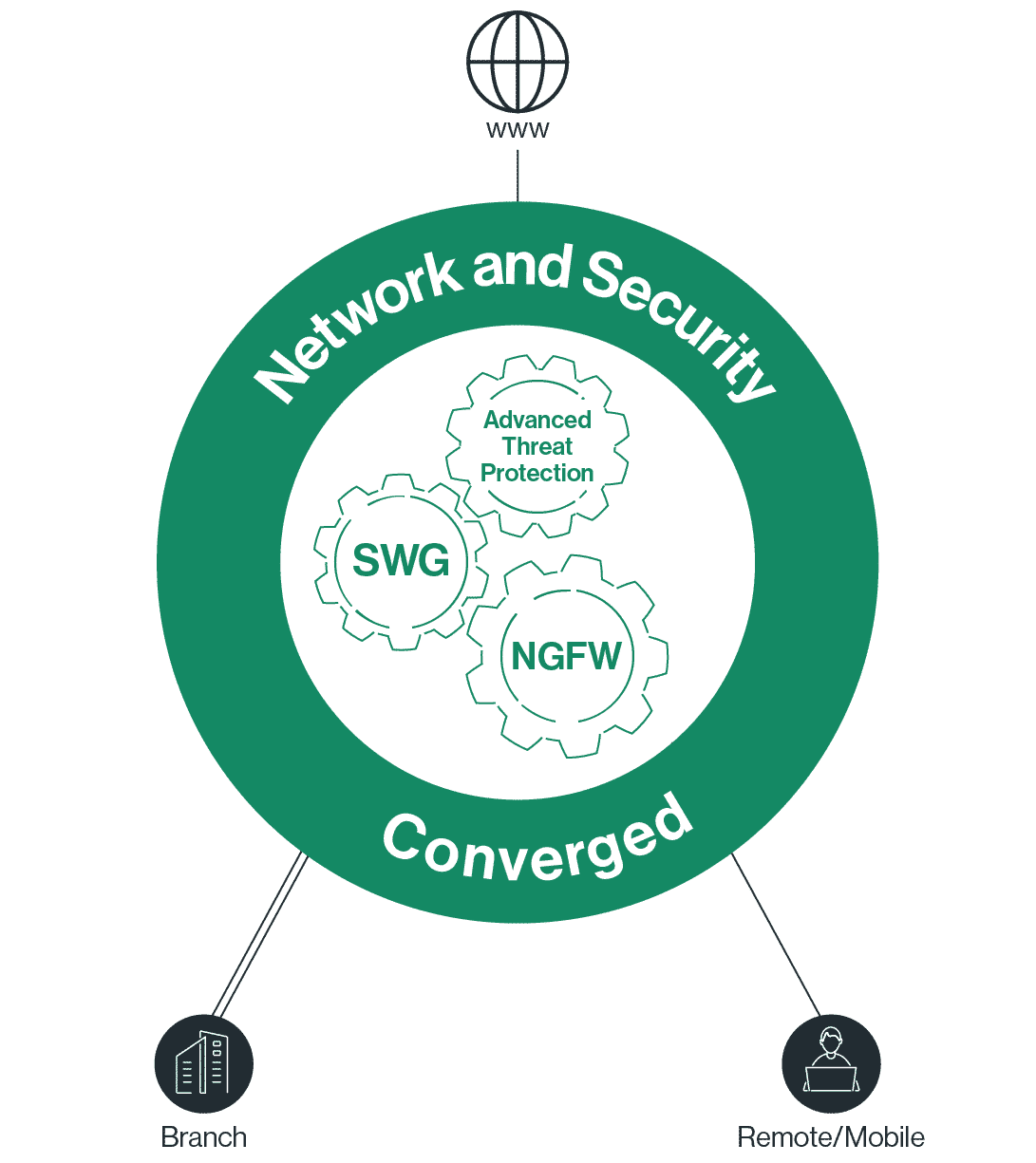Secure Web Gateway (SWG)
Cloud-based Secure Web Gateway protects users against Internet-borne threats.
Secure Web Gateway (SWG) protects users against phishing, malware and other Internet-borne threats. Unlike traditional firewalls, Secure Web Gateways are focused on layer 7 web traffic inspection, both inbound and outbound. As web security solutions, they apply no protection to WAN traffic, which is left to the corporate Next Generation Firewalls. In recent years, Secure Web Gateways appeared as cloud services. The cloud instances enable secure web and cloud access from anywhere – including outside the office by mobile users. The traffic coverage and solution form factor remain the key distinctions between Secure Web Gateways and Next Generation Firewalls who often provide a very similar level of security capabilities.
A converged, cloud-based network security solution converges the capabilities of a Next Generation Firewall (WAN and Internet traffic inspection) and the extended coverage for mobile users of Secure Web Gateways.
A converged approach eliminates the need to maintain policies across multiple point solutions and the appliance life cycle.

The Cato Solution: Converged Network Security in the Cloud
Cato is providing a new kind of a network security stack that converges a Next Generation Firewall, Secure Web Gateway and Advanced Threat Protection in the cloud. All these capabilities are available everywhere without deploying discrete appliances and cloud-based services.
The Cato Cloud aggregates all enterprise traffic including data centers, branches, mobile users, cloud infrastructure into a cloud network with built-in network security stack. Cato enforces comprehensive security policy on all traffic, both WAN- and Internet-bound and all users, both fixed location and mobile.

„The other provider’s service would have meant spending around 2x more than with the Cato solution and still not get any of the security services Cato offers.”

Appliance-based Secure Web Gateway Challenges vs.
Converged Network Security in the Cloud
Legacy
Legacy
Cato
Cato
Visibility
Legacy
Fragmented visibility
A Secure Web Gateway appliance needs to sit in the data path to be able to process enterprise traffic. An appliance is required at every location that accesses the Internet.
Cato
Full visibility
As all WAN and Internet traffic goes through the Cato Cloud there are no blind spots and no need to deploy multiple appliances, of different providers, to cover all traffic.
Scalability
Legacy
Capacity constrained security
A Secure Web Gateway applies various security engines to the traffic including IPS, anti-malware, URL filtering and more. The ability to run these engines in parallel is subject to the appliance capacity. Smaller appliances, such as UTMs, are especially limited in their scalability, extensibility and inspection capabilities.
Cato
Unrestricted scalability
Cato can inspect any mix of encrypted and unencrypted traffic with all supported security services. Customers don’t have to go through sizing exercises or forced upgrades. Cato ensures capacity is available to provide customers the subscribed service.
Inspection
Legacy
SSL inspection degredation
A Secure Web Gateway needs to inspect both encrypted (SSL) and unencrypted traffic at line speed. As the share of SSL traffic increases, forced appliance upgrades may become a necessity.
Cato
Full traffic inspection with no degredation
Cato can inspect all traffic, both encrypted and unencrypted with all supported security services and with no performance degradation. Inspection capacity is handled exclusively by Cato to ensure support for licensed capacity.
Manageability
Legacy
Complex appliance management
A distributed environment requires multiple appliances at each location, each with its own set of rules. Each appliance life cycle has to be managed separately. It has to be bought, deployed, configured, patched, updated and ultimately replaced either due to an End of Life (EOL) or business growth.
Cato
Self-maintaining cloud service
Without the need to size, upgrade, patch or refresh appliances, customers are relieved of the on going grunt work of keeping their network security up to date against emerging threats and evolving business needs.
Legacy
Cato
Visibility
Fragmented visibility
A Secure Web Gateway appliance needs to sit in the data path to be able to process enterprise traffic. An appliance is required at every location that accesses the Internet.
Full visibility
As all WAN and Internet traffic goes through the Cato Cloud there are no blind spots and no need to deploy multiple appliances, of different providers, to cover all traffic.
Scalability
Capacity constrained security
A Secure Web Gateway applies various security engines to the traffic including IPS, anti-malware, URL filtering and more. The ability to run these engines in parallel is subject to the appliance capacity. Smaller appliances, such as UTMs, are especially limited in their scalability, extensibility and inspection capabilities.
Unrestricted scalability
Cato can inspect any mix of encrypted and unencrypted traffic with all supported security services. Customers don’t have to go through sizing exercises or forced upgrades. Cato ensures capacity is available to provide customers the subscribed service.
Inspection
SSL inspection degredation
A Secure Web Gateway needs to inspect both encrypted (SSL) and unencrypted traffic at line speed. As the share of SSL traffic increases, forced appliance upgrades may become a necessity.
Full traffic inspection with no degredation
Cato can inspect all traffic, both encrypted and unencrypted with all supported security services and with no performance degradation. Inspection capacity is handled exclusively by Cato to ensure support for licensed capacity.
Manageability
Complex appliance management
A distributed environment requires multiple appliances at each location, each with its own set of rules. Each appliance life cycle has to be managed separately. It has to be bought, deployed, configured, patched, updated and ultimately replaced either due to an End of Life (EOL) or business growth.
Self-maintaining cloud service
Without the need to size, upgrade, patch or refresh appliances, customers are relieved of the on going grunt work of keeping their network security up to date against emerging threats and evolving business needs.



